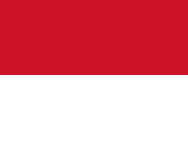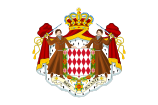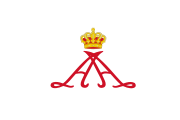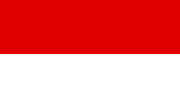- Flag of Monaco
-
Flag of Monaco
Use Civil and state flag and ensign 

Proportion 4:5 (or 2:3) Adopted 4 April 1881 Design two equal horizontal bands, red (top) and white (bottom) 
Variant flag of Monaco 
Variant flag of Monaco The national flag of Monaco (French: Drapeau de Monaco) has two equal horizontal bands of red (top) and white, both of which have been the heraldic colors of the House of Grimaldi since at least 1339. The present bicolor design was adopted on April 4, 1881, under Prince Charles III.
Monaco's original flag, which was similar to its current state flag but bore an older version of its coat of arms, was in use from the principality's early days (except during its annexation to France from 1793 to 1814) until the present, simpler design was adopted in 1881.
Another design (below), the banner of the state arms (lozenges in the Grimaldi family colors, in heraldic terms "lozengy argent and gules"), was used at various times, particularly in the 17th century, as an unofficial flag, and still appears in some royal photographs. However, it has no designated use, and does not represent any Monegasque official in particular.
Contents
State flag
Monaco's state flag, which consists of the full achievement of the coat of arms on a white background with a red line, is flown at government offices, the Prince's palace, in the presence of government officials, and as an ensign on the Prince's yacht.
Princely standard
The princely standard, which consisted of the Crown of Monaco over two opposing letters A on a white background, is the personal flag of Prince Albert II, and is only used in his immediate presence, particularly on cars in which he travels. It is often seen with a gold fringe on the top, bottom, and right, which is one-ninth the height of the white field.
Similar flags
Except for its proportions, the flag of Monaco is identical to the flags of Indonesia and the German state of Hesse (both of which are longer). It is also similar to the flags of Singapore (which has a crescent and five stars in the top left), Poland and the German state of Thuringia (the order of the colours is reversed on the latter two). Monaco's flag is one of the world's oldest flags.
Notes
- Sources disagree as to the flag's usage. According to Flags of the World it is
 ; according to the World Flag Database it is
; according to the World Flag Database it is  ; and according to Whitney Smith's Flags Through the Ages and Across the World (1975), it is
; and according to Whitney Smith's Flags Through the Ages and Across the World (1975), it is  .
.
References
- Explanation of the use of Monaco's various flags
- World Flag Database Monaco's flags at the World Flag Database
Flags of Europe Sovereign
states- Albania
- Andorra
- Armenia
- Austria
- Azerbaijan
- Belarus
- Belgium
- Bosnia and Herzegovina
- Bulgaria
- Croatia
- Cyprus
- Czech Republic
- Denmark
- Estonia
- Finland
- France
- Georgia
- Germany
- Greece
- Hungary
- Iceland
- Ireland
- Italy
- Kazakhstan
- Latvia
- Liechtenstein
- Lithuania
- Luxembourg
- Macedonia
- Malta
- Moldova
- Monaco
- Montenegro
- Netherlands
- Norway
- Poland
- Portugal
- Romania
- Russia
- San Marino
- Serbia
- Slovakia
- Slovenia
- Spain
- Sweden
- Switzerland
- Turkey
- Ukraine
- United Kingdom
- (England
- Northern Ireland
- Scotland
- Wales)
- Vatican City
States with limited
recognition- Abkhazia
- Kosovo
- Nagorno-Karabakh
- Northern Cyprus
- South Ossetia
- Transnistria
Dependencies
and other territories- Åland
- Faroe Islands
- Gibraltar
- Guernsey
- Jan Mayen
- Jersey
- Isle of Man
- Svalbard
Other entities - European Union
National flags and coats of arms National flags National coats of arms Categories:- National symbols of Monaco
- National flags
- Sources disagree as to the flag's usage. According to Flags of the World it is
Wikimedia Foundation. 2010.


